Leadership and Team Development for KPMG Operations Manager at Sydney
VerifiedAdded on 2022/12/29
|14
|3316
|29
Report
AI Summary
This report delves into the crucial aspects of leadership styles, specifically focusing on transformational and transactional approaches, and their impact on team effectiveness and company growth within the context of KPMG. It outlines diverse strategies that an operations manager can implement, emphasizing team performance planning and key performance indicators (KPIs). The report also covers the importance of stakeholder meetings, communication strategies, and fostering a collaborative environment. Furthermore, it addresses techniques for team cohesion, conflict management, and the integration of personal leadership styles. A team performance plan is included to illustrate the priorities of an operations manager. The report provides a comprehensive overview of leadership principles and practical applications within a multinational company setting, highlighting strategies for monitoring performance, encouraging shared understanding, and effectively communicating with stakeholders. The report concludes with a discussion on managing conflict and introducing collaborative work relationships for optimum performance.
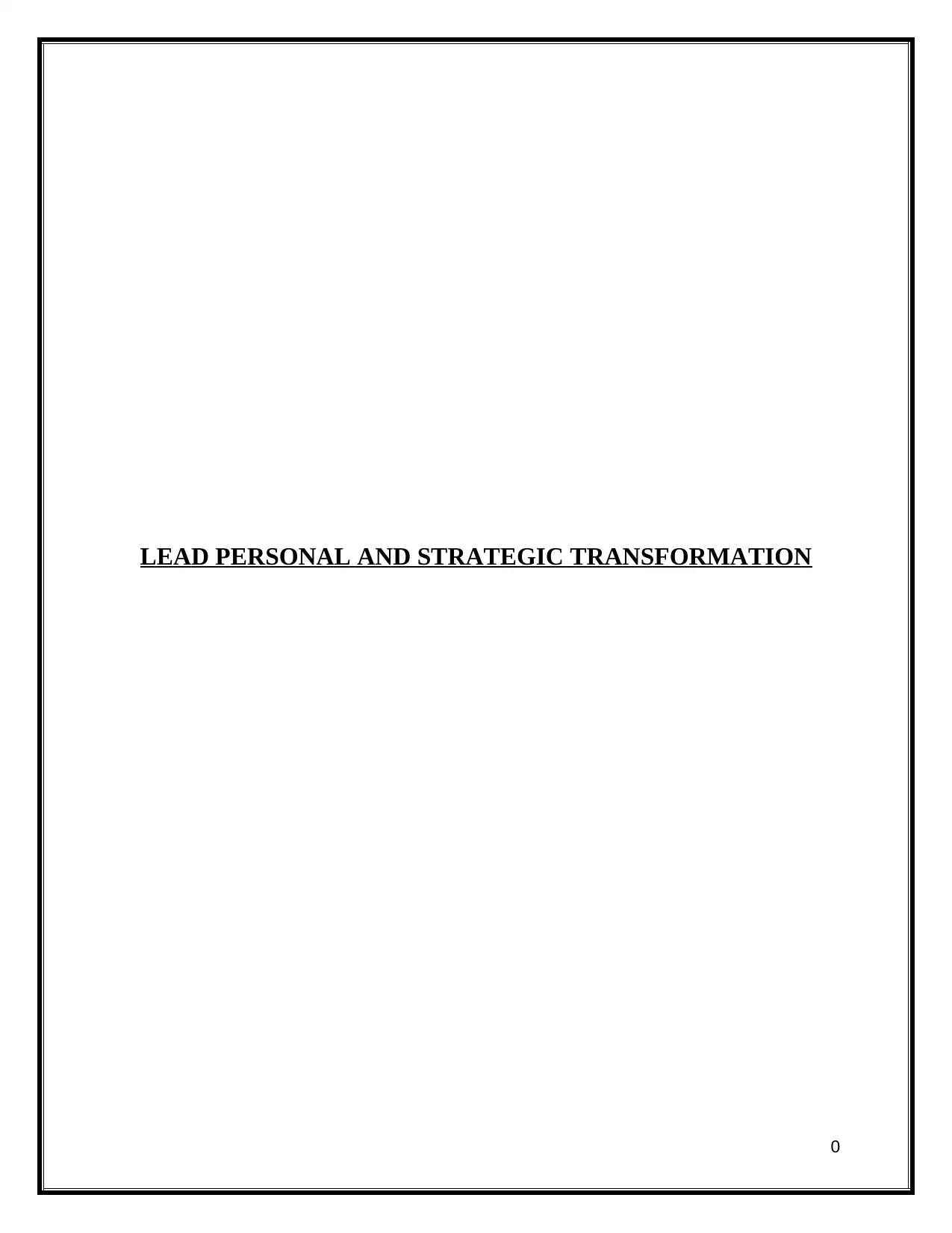
LEAD PERSONAL AND STRATEGIC TRANSFORMATION
0
0
Paraphrase This Document
Need a fresh take? Get an instant paraphrase of this document with our AI Paraphraser
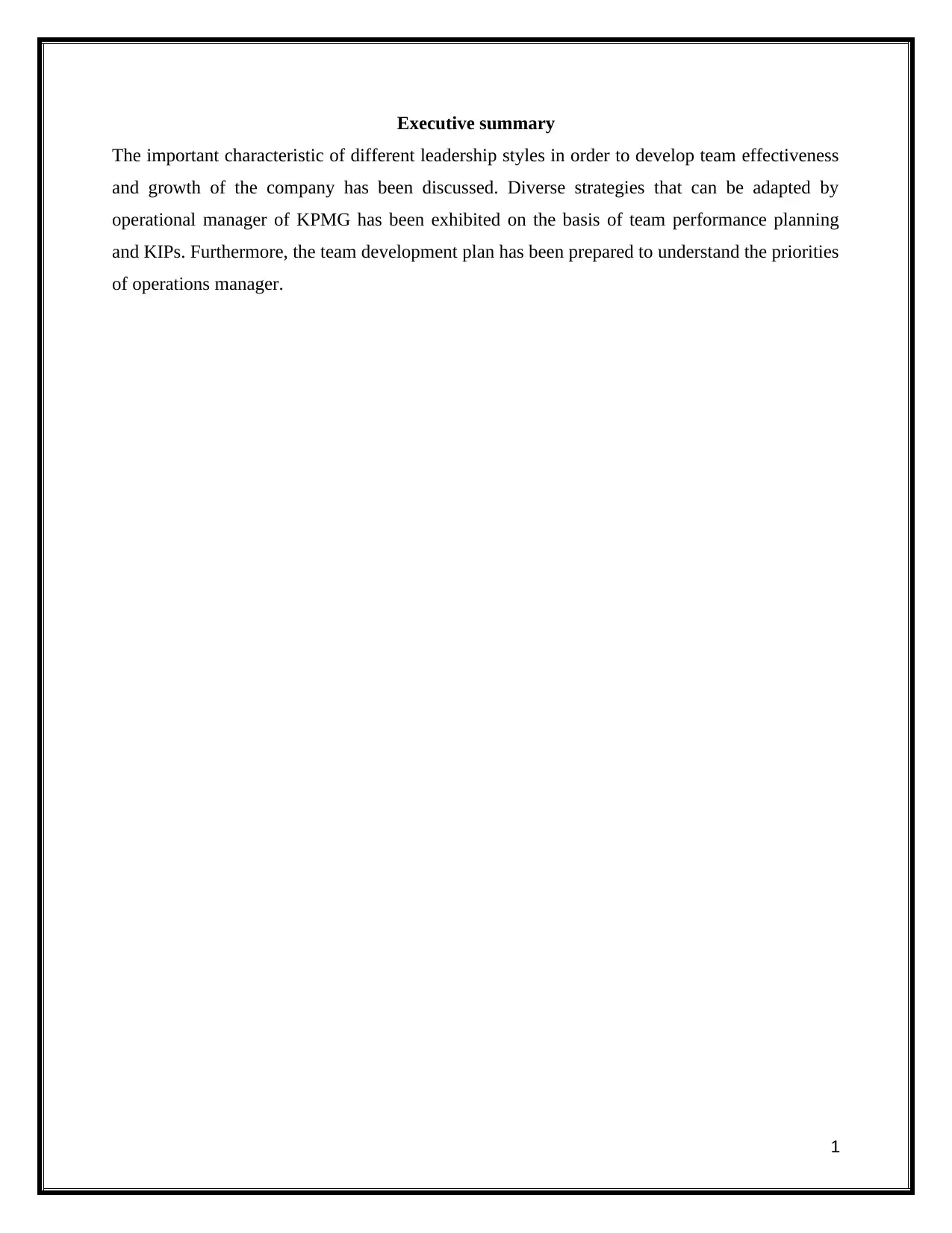
Executive summary
The important characteristic of different leadership styles in order to develop team effectiveness
and growth of the company has been discussed. Diverse strategies that can be adapted by
operational manager of KPMG has been exhibited on the basis of team performance planning
and KIPs. Furthermore, the team development plan has been prepared to understand the priorities
of operations manager.
1
The important characteristic of different leadership styles in order to develop team effectiveness
and growth of the company has been discussed. Diverse strategies that can be adapted by
operational manager of KPMG has been exhibited on the basis of team performance planning
and KIPs. Furthermore, the team development plan has been prepared to understand the priorities
of operations manager.
1
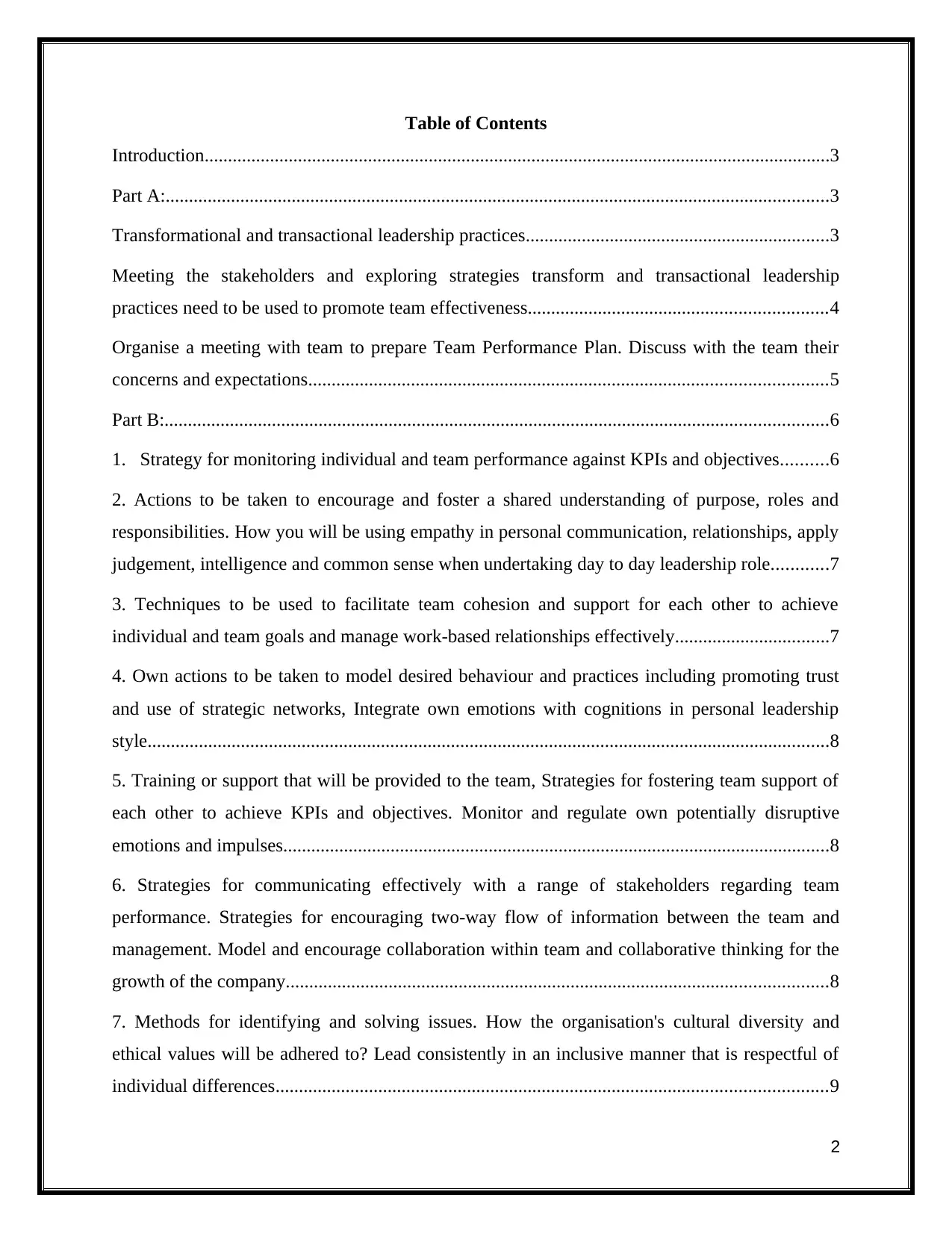
Table of Contents
Introduction......................................................................................................................................3
Part A:..............................................................................................................................................3
Transformational and transactional leadership practices.................................................................3
Meeting the stakeholders and exploring strategies transform and transactional leadership
practices need to be used to promote team effectiveness................................................................4
Organise a meeting with team to prepare Team Performance Plan. Discuss with the team their
concerns and expectations...............................................................................................................5
Part B:..............................................................................................................................................6
1. Strategy for monitoring individual and team performance against KPIs and objectives..........6
2. Actions to be taken to encourage and foster a shared understanding of purpose, roles and
responsibilities. How you will be using empathy in personal communication, relationships, apply
judgement, intelligence and common sense when undertaking day to day leadership role............7
3. Techniques to be used to facilitate team cohesion and support for each other to achieve
individual and team goals and manage work-based relationships effectively.................................7
4. Own actions to be taken to model desired behaviour and practices including promoting trust
and use of strategic networks, Integrate own emotions with cognitions in personal leadership
style..................................................................................................................................................8
5. Training or support that will be provided to the team, Strategies for fostering team support of
each other to achieve KPIs and objectives. Monitor and regulate own potentially disruptive
emotions and impulses.....................................................................................................................8
6. Strategies for communicating effectively with a range of stakeholders regarding team
performance. Strategies for encouraging two-way flow of information between the team and
management. Model and encourage collaboration within team and collaborative thinking for the
growth of the company....................................................................................................................8
7. Methods for identifying and solving issues. How the organisation's cultural diversity and
ethical values will be adhered to? Lead consistently in an inclusive manner that is respectful of
individual differences......................................................................................................................9
2
Introduction......................................................................................................................................3
Part A:..............................................................................................................................................3
Transformational and transactional leadership practices.................................................................3
Meeting the stakeholders and exploring strategies transform and transactional leadership
practices need to be used to promote team effectiveness................................................................4
Organise a meeting with team to prepare Team Performance Plan. Discuss with the team their
concerns and expectations...............................................................................................................5
Part B:..............................................................................................................................................6
1. Strategy for monitoring individual and team performance against KPIs and objectives..........6
2. Actions to be taken to encourage and foster a shared understanding of purpose, roles and
responsibilities. How you will be using empathy in personal communication, relationships, apply
judgement, intelligence and common sense when undertaking day to day leadership role............7
3. Techniques to be used to facilitate team cohesion and support for each other to achieve
individual and team goals and manage work-based relationships effectively.................................7
4. Own actions to be taken to model desired behaviour and practices including promoting trust
and use of strategic networks, Integrate own emotions with cognitions in personal leadership
style..................................................................................................................................................8
5. Training or support that will be provided to the team, Strategies for fostering team support of
each other to achieve KPIs and objectives. Monitor and regulate own potentially disruptive
emotions and impulses.....................................................................................................................8
6. Strategies for communicating effectively with a range of stakeholders regarding team
performance. Strategies for encouraging two-way flow of information between the team and
management. Model and encourage collaboration within team and collaborative thinking for the
growth of the company....................................................................................................................8
7. Methods for identifying and solving issues. How the organisation's cultural diversity and
ethical values will be adhered to? Lead consistently in an inclusive manner that is respectful of
individual differences......................................................................................................................9
2
⊘ This is a preview!⊘
Do you want full access?
Subscribe today to unlock all pages.

Trusted by 1+ million students worldwide
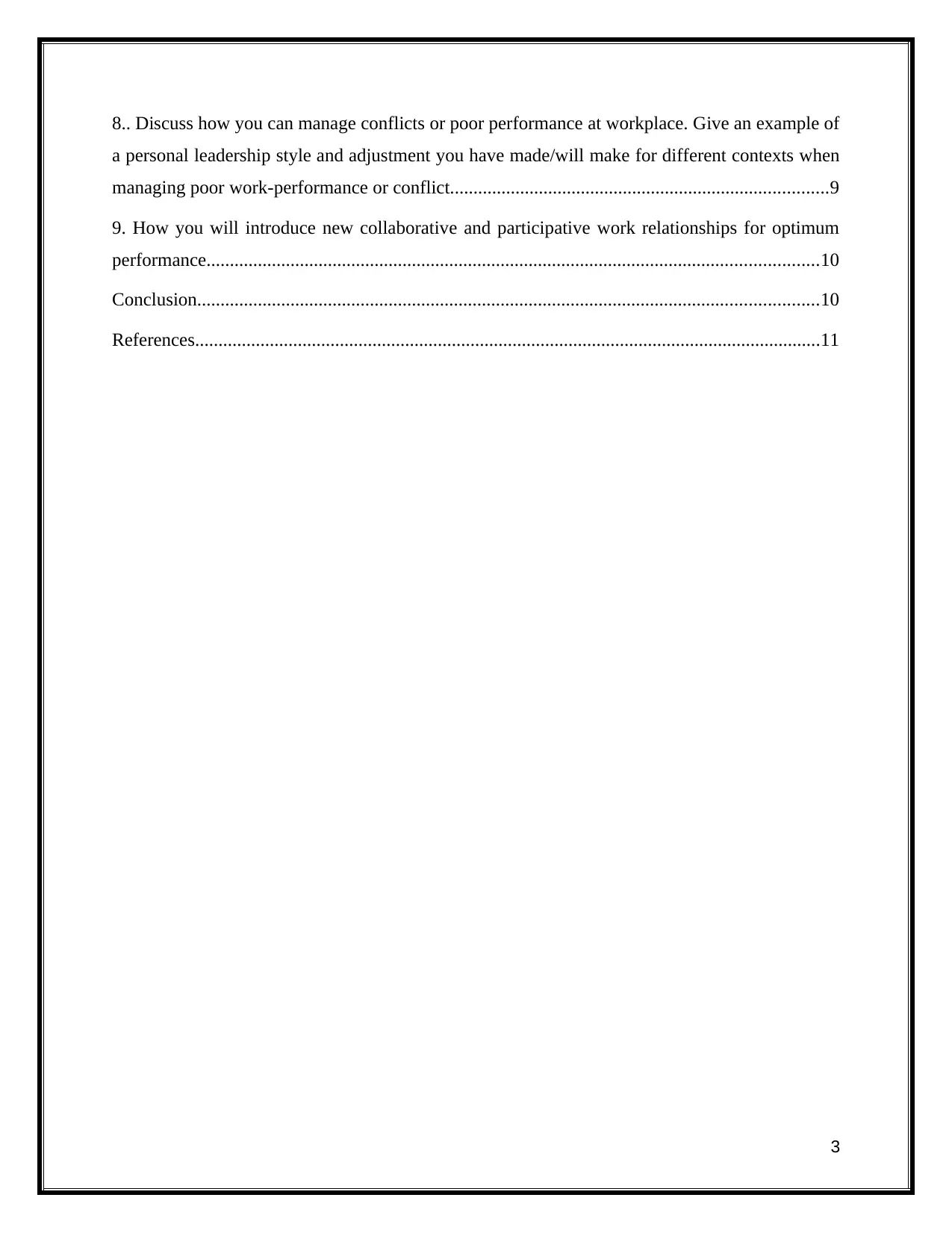
8.. Discuss how you can manage conflicts or poor performance at workplace. Give an example of
a personal leadership style and adjustment you have made/will make for different contexts when
managing poor work-performance or conflict.................................................................................9
9. How you will introduce new collaborative and participative work relationships for optimum
performance...................................................................................................................................10
Conclusion.....................................................................................................................................10
References......................................................................................................................................11
3
a personal leadership style and adjustment you have made/will make for different contexts when
managing poor work-performance or conflict.................................................................................9
9. How you will introduce new collaborative and participative work relationships for optimum
performance...................................................................................................................................10
Conclusion.....................................................................................................................................10
References......................................................................................................................................11
3
Paraphrase This Document
Need a fresh take? Get an instant paraphrase of this document with our AI Paraphraser
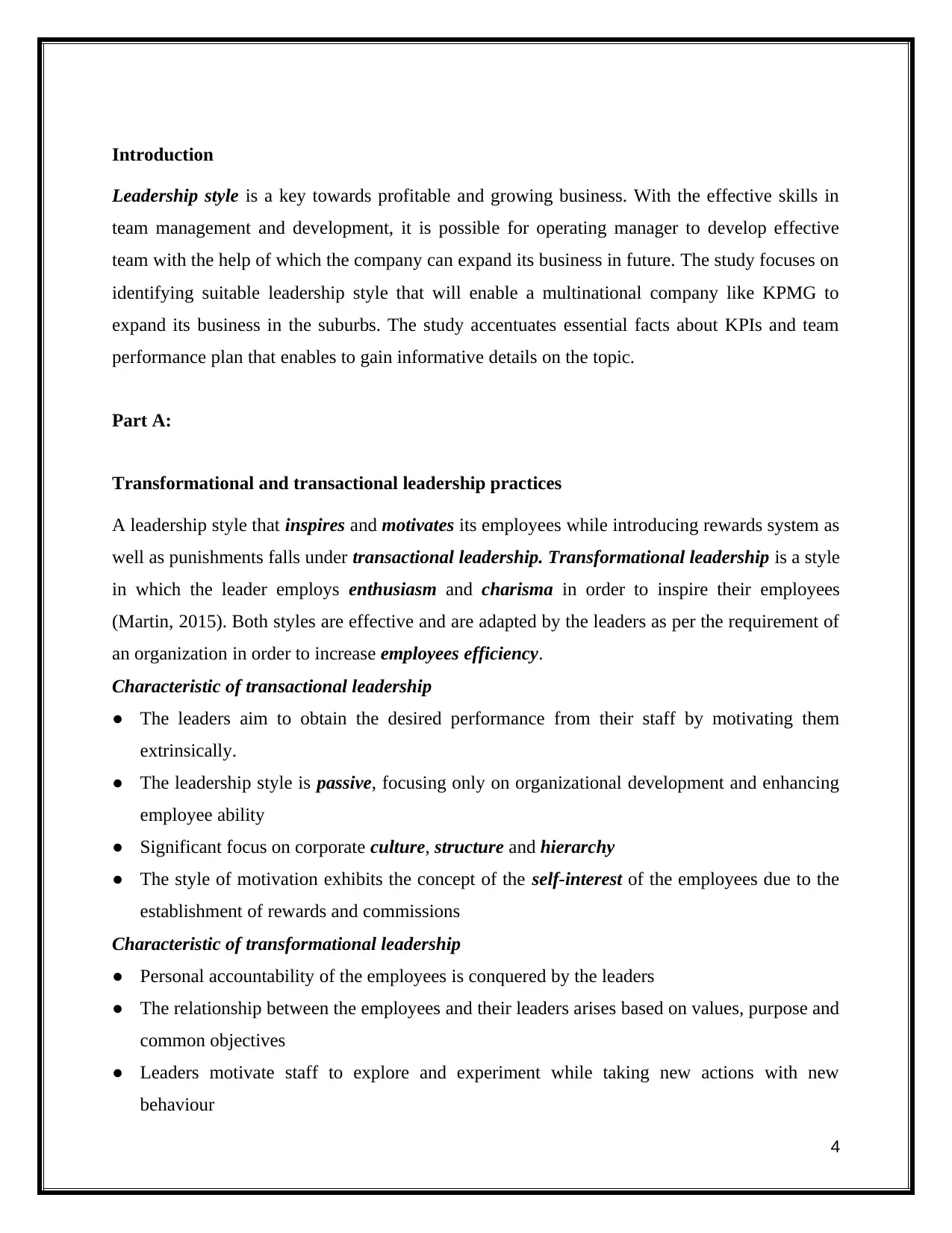
Introduction
Leadership style is a key towards profitable and growing business. With the effective skills in
team management and development, it is possible for operating manager to develop effective
team with the help of which the company can expand its business in future. The study focuses on
identifying suitable leadership style that will enable a multinational company like KPMG to
expand its business in the suburbs. The study accentuates essential facts about KPIs and team
performance plan that enables to gain informative details on the topic.
Part A:
Transformational and transactional leadership practices
A leadership style that inspires and motivates its employees while introducing rewards system as
well as punishments falls under transactional leadership. Transformational leadership is a style
in which the leader employs enthusiasm and charisma in order to inspire their employees
(Martin, 2015). Both styles are effective and are adapted by the leaders as per the requirement of
an organization in order to increase employees efficiency.
Characteristic of transactional leadership
● The leaders aim to obtain the desired performance from their staff by motivating them
extrinsically.
● The leadership style is passive, focusing only on organizational development and enhancing
employee ability
● Significant focus on corporate culture, structure and hierarchy
● The style of motivation exhibits the concept of the self-interest of the employees due to the
establishment of rewards and commissions
Characteristic of transformational leadership
● Personal accountability of the employees is conquered by the leaders
● The relationship between the employees and their leaders arises based on values, purpose and
common objectives
● Leaders motivate staff to explore and experiment while taking new actions with new
behaviour
4
Leadership style is a key towards profitable and growing business. With the effective skills in
team management and development, it is possible for operating manager to develop effective
team with the help of which the company can expand its business in future. The study focuses on
identifying suitable leadership style that will enable a multinational company like KPMG to
expand its business in the suburbs. The study accentuates essential facts about KPIs and team
performance plan that enables to gain informative details on the topic.
Part A:
Transformational and transactional leadership practices
A leadership style that inspires and motivates its employees while introducing rewards system as
well as punishments falls under transactional leadership. Transformational leadership is a style
in which the leader employs enthusiasm and charisma in order to inspire their employees
(Martin, 2015). Both styles are effective and are adapted by the leaders as per the requirement of
an organization in order to increase employees efficiency.
Characteristic of transactional leadership
● The leaders aim to obtain the desired performance from their staff by motivating them
extrinsically.
● The leadership style is passive, focusing only on organizational development and enhancing
employee ability
● Significant focus on corporate culture, structure and hierarchy
● The style of motivation exhibits the concept of the self-interest of the employees due to the
establishment of rewards and commissions
Characteristic of transformational leadership
● Personal accountability of the employees is conquered by the leaders
● The relationship between the employees and their leaders arises based on values, purpose and
common objectives
● Leaders motivate staff to explore and experiment while taking new actions with new
behaviour
4
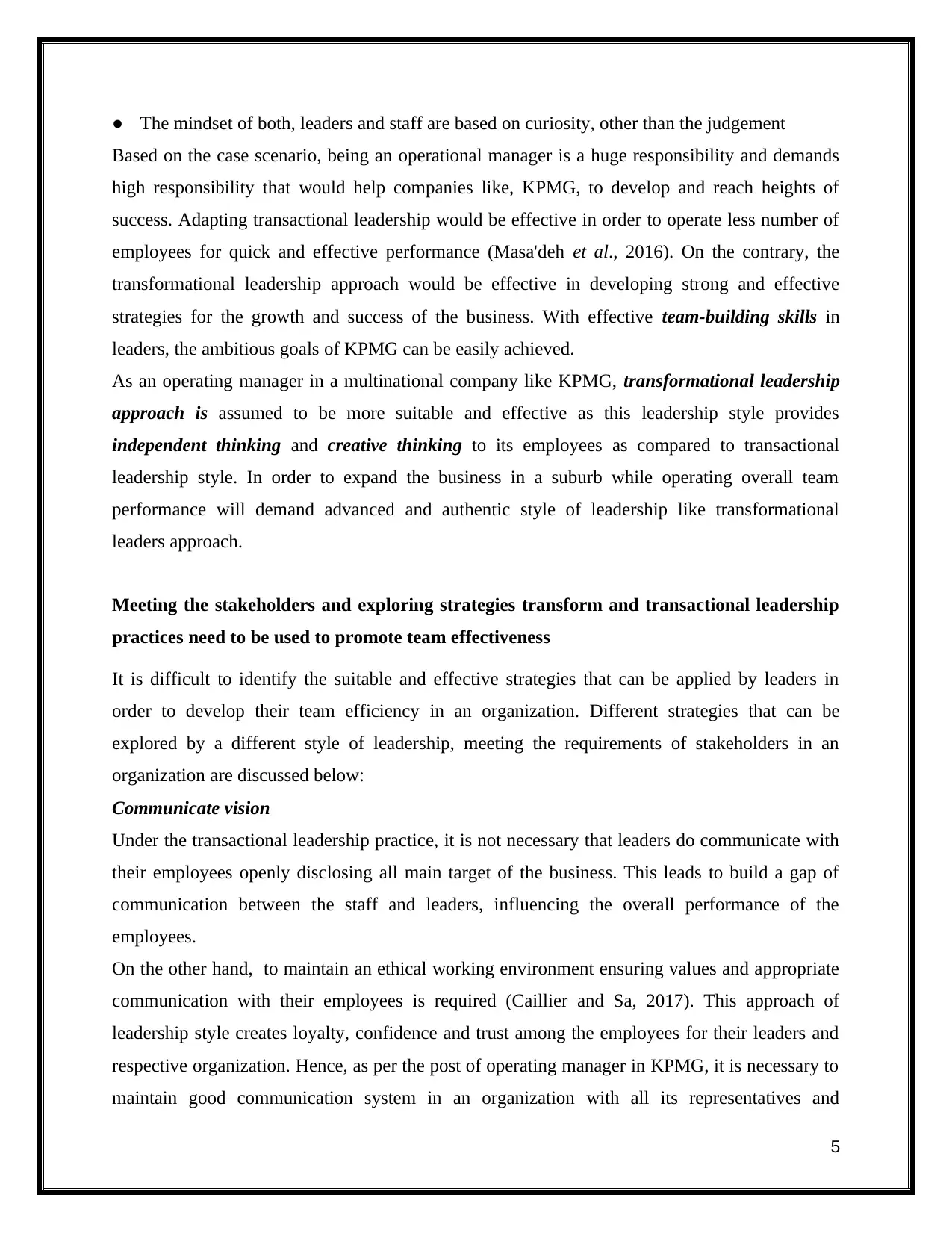
● The mindset of both, leaders and staff are based on curiosity, other than the judgement
Based on the case scenario, being an operational manager is a huge responsibility and demands
high responsibility that would help companies like, KPMG, to develop and reach heights of
success. Adapting transactional leadership would be effective in order to operate less number of
employees for quick and effective performance (Masa'deh et al., 2016). On the contrary, the
transformational leadership approach would be effective in developing strong and effective
strategies for the growth and success of the business. With effective team-building skills in
leaders, the ambitious goals of KPMG can be easily achieved.
As an operating manager in a multinational company like KPMG, transformational leadership
approach is assumed to be more suitable and effective as this leadership style provides
independent thinking and creative thinking to its employees as compared to transactional
leadership style. In order to expand the business in a suburb while operating overall team
performance will demand advanced and authentic style of leadership like transformational
leaders approach.
Meeting the stakeholders and exploring strategies transform and transactional leadership
practices need to be used to promote team effectiveness
It is difficult to identify the suitable and effective strategies that can be applied by leaders in
order to develop their team efficiency in an organization. Different strategies that can be
explored by a different style of leadership, meeting the requirements of stakeholders in an
organization are discussed below:
Communicate vision
Under the transactional leadership practice, it is not necessary that leaders do communicate with
their employees openly disclosing all main target of the business. This leads to build a gap of
communication between the staff and leaders, influencing the overall performance of the
employees.
On the other hand, to maintain an ethical working environment ensuring values and appropriate
communication with their employees is required (Caillier and Sa, 2017). This approach of
leadership style creates loyalty, confidence and trust among the employees for their leaders and
respective organization. Hence, as per the post of operating manager in KPMG, it is necessary to
maintain good communication system in an organization with all its representatives and
5
Based on the case scenario, being an operational manager is a huge responsibility and demands
high responsibility that would help companies like, KPMG, to develop and reach heights of
success. Adapting transactional leadership would be effective in order to operate less number of
employees for quick and effective performance (Masa'deh et al., 2016). On the contrary, the
transformational leadership approach would be effective in developing strong and effective
strategies for the growth and success of the business. With effective team-building skills in
leaders, the ambitious goals of KPMG can be easily achieved.
As an operating manager in a multinational company like KPMG, transformational leadership
approach is assumed to be more suitable and effective as this leadership style provides
independent thinking and creative thinking to its employees as compared to transactional
leadership style. In order to expand the business in a suburb while operating overall team
performance will demand advanced and authentic style of leadership like transformational
leaders approach.
Meeting the stakeholders and exploring strategies transform and transactional leadership
practices need to be used to promote team effectiveness
It is difficult to identify the suitable and effective strategies that can be applied by leaders in
order to develop their team efficiency in an organization. Different strategies that can be
explored by a different style of leadership, meeting the requirements of stakeholders in an
organization are discussed below:
Communicate vision
Under the transactional leadership practice, it is not necessary that leaders do communicate with
their employees openly disclosing all main target of the business. This leads to build a gap of
communication between the staff and leaders, influencing the overall performance of the
employees.
On the other hand, to maintain an ethical working environment ensuring values and appropriate
communication with their employees is required (Caillier and Sa, 2017). This approach of
leadership style creates loyalty, confidence and trust among the employees for their leaders and
respective organization. Hence, as per the post of operating manager in KPMG, it is necessary to
maintain good communication system in an organization with all its representatives and
5
⊘ This is a preview!⊘
Do you want full access?
Subscribe today to unlock all pages.

Trusted by 1+ million students worldwide
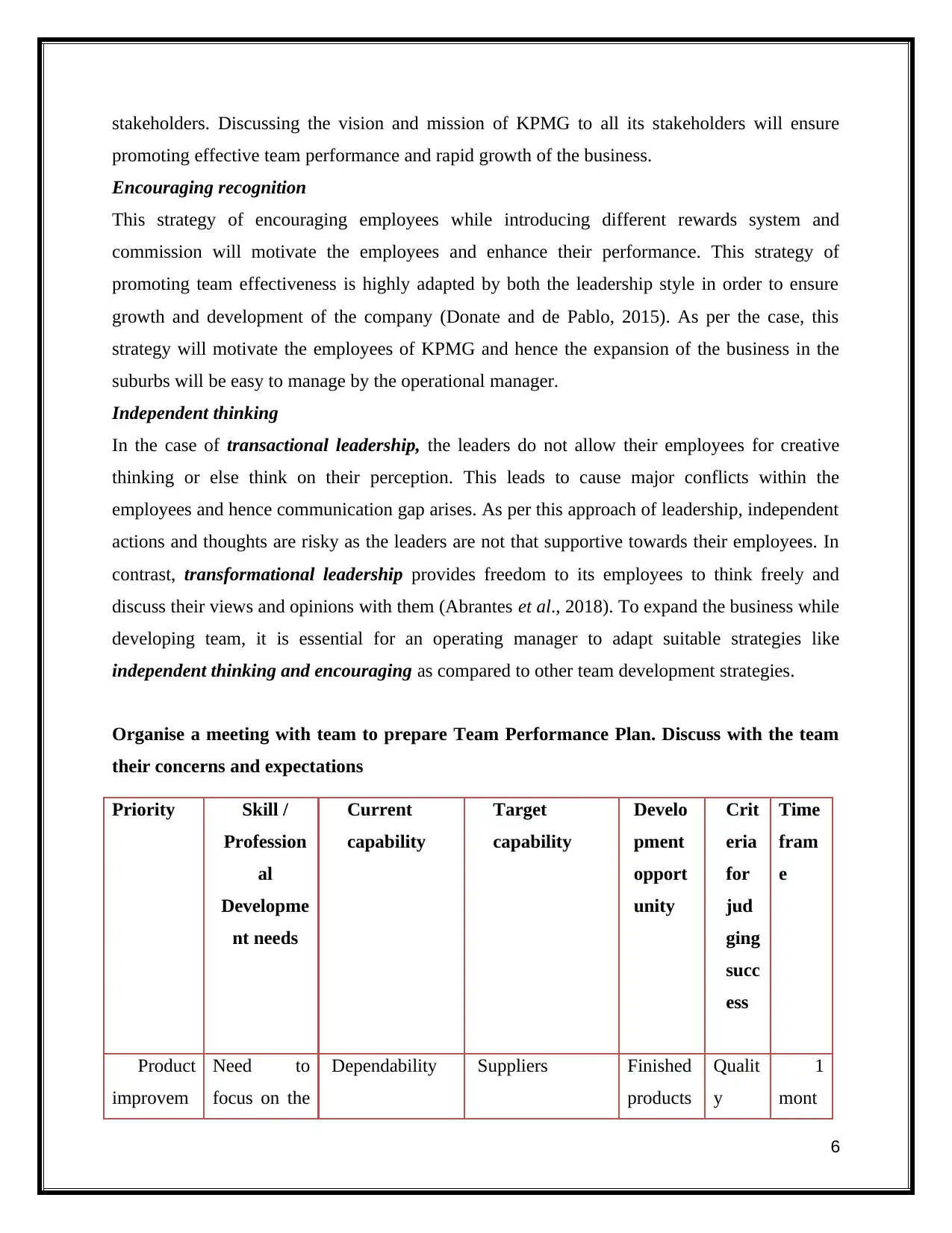
stakeholders. Discussing the vision and mission of KPMG to all its stakeholders will ensure
promoting effective team performance and rapid growth of the business.
Encouraging recognition
This strategy of encouraging employees while introducing different rewards system and
commission will motivate the employees and enhance their performance. This strategy of
promoting team effectiveness is highly adapted by both the leadership style in order to ensure
growth and development of the company (Donate and de Pablo, 2015). As per the case, this
strategy will motivate the employees of KPMG and hence the expansion of the business in the
suburbs will be easy to manage by the operational manager.
Independent thinking
In the case of transactional leadership, the leaders do not allow their employees for creative
thinking or else think on their perception. This leads to cause major conflicts within the
employees and hence communication gap arises. As per this approach of leadership, independent
actions and thoughts are risky as the leaders are not that supportive towards their employees. In
contrast, transformational leadership provides freedom to its employees to think freely and
discuss their views and opinions with them (Abrantes et al., 2018). To expand the business while
developing team, it is essential for an operating manager to adapt suitable strategies like
independent thinking and encouraging as compared to other team development strategies.
Organise a meeting with team to prepare Team Performance Plan. Discuss with the team
their concerns and expectations
Priority Skill /
Profession
al
Developme
nt needs
Current
capability
Target
capability
Develo
pment
opport
unity
Crit
eria
for
jud
ging
succ
ess
Time
fram
e
Product
improvem
Need to
focus on the
Dependability Suppliers Finished
products
Qualit
y
1
mont
6
promoting effective team performance and rapid growth of the business.
Encouraging recognition
This strategy of encouraging employees while introducing different rewards system and
commission will motivate the employees and enhance their performance. This strategy of
promoting team effectiveness is highly adapted by both the leadership style in order to ensure
growth and development of the company (Donate and de Pablo, 2015). As per the case, this
strategy will motivate the employees of KPMG and hence the expansion of the business in the
suburbs will be easy to manage by the operational manager.
Independent thinking
In the case of transactional leadership, the leaders do not allow their employees for creative
thinking or else think on their perception. This leads to cause major conflicts within the
employees and hence communication gap arises. As per this approach of leadership, independent
actions and thoughts are risky as the leaders are not that supportive towards their employees. In
contrast, transformational leadership provides freedom to its employees to think freely and
discuss their views and opinions with them (Abrantes et al., 2018). To expand the business while
developing team, it is essential for an operating manager to adapt suitable strategies like
independent thinking and encouraging as compared to other team development strategies.
Organise a meeting with team to prepare Team Performance Plan. Discuss with the team
their concerns and expectations
Priority Skill /
Profession
al
Developme
nt needs
Current
capability
Target
capability
Develo
pment
opport
unity
Crit
eria
for
jud
ging
succ
ess
Time
fram
e
Product
improvem
Need to
focus on the
Dependability Suppliers Finished
products
Qualit
y
1
mont
6
Paraphrase This Document
Need a fresh take? Get an instant paraphrase of this document with our AI Paraphraser
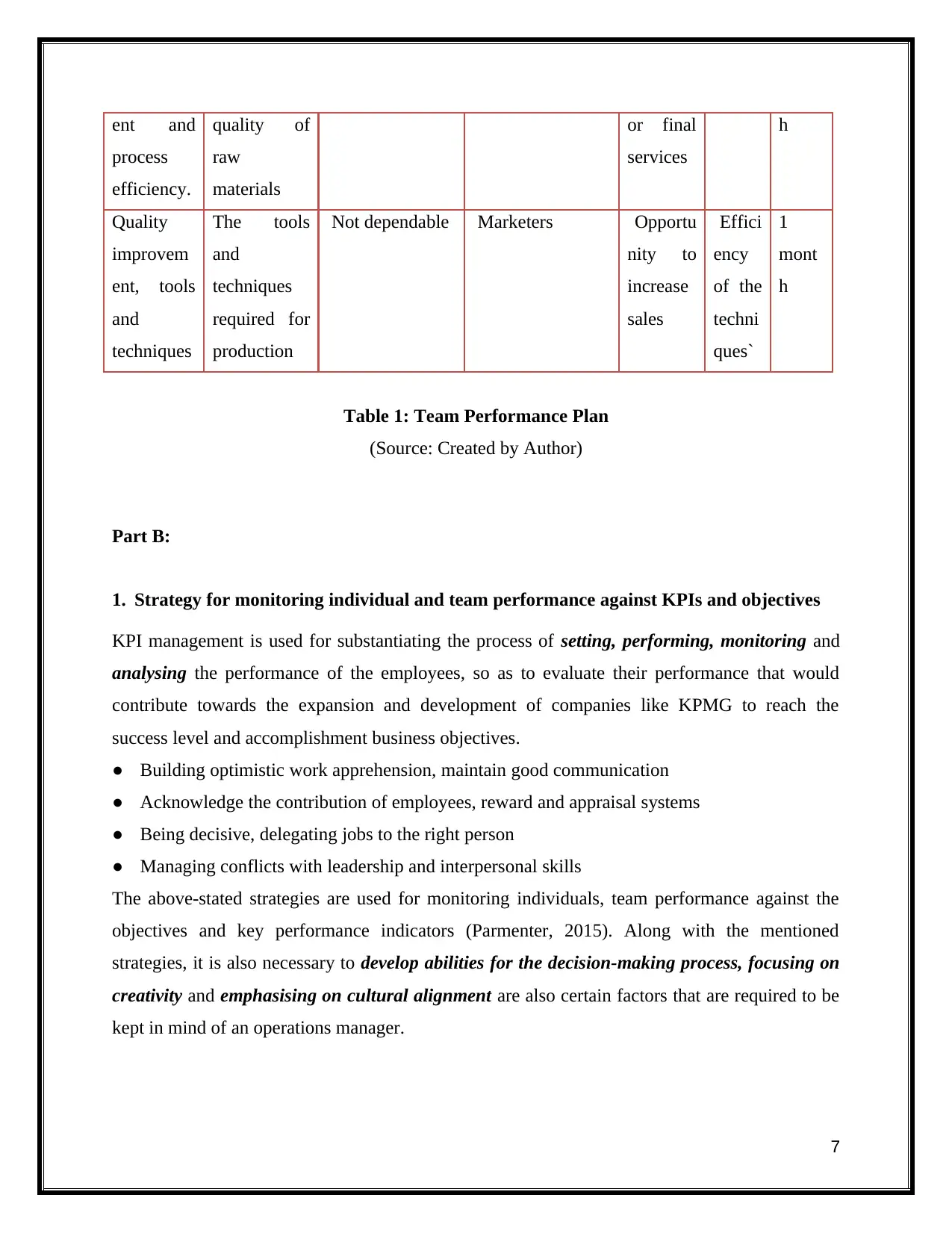
ent and
process
efficiency.
quality of
raw
materials
or final
services
h
Quality
improvem
ent, tools
and
techniques
The tools
and
techniques
required for
production
Not dependable Marketers Opportu
nity to
increase
sales
Effici
ency
of the
techni
ques`
1
mont
h
Table 1: Team Performance Plan
(Source: Created by Author)
Part B:
1. Strategy for monitoring individual and team performance against KPIs and objectives
KPI management is used for substantiating the process of setting, performing, monitoring and
analysing the performance of the employees, so as to evaluate their performance that would
contribute towards the expansion and development of companies like KPMG to reach the
success level and accomplishment business objectives.
● Building optimistic work apprehension, maintain good communication
● Acknowledge the contribution of employees, reward and appraisal systems
● Being decisive, delegating jobs to the right person
● Managing conflicts with leadership and interpersonal skills
The above-stated strategies are used for monitoring individuals, team performance against the
objectives and key performance indicators (Parmenter, 2015). Along with the mentioned
strategies, it is also necessary to develop abilities for the decision-making process, focusing on
creativity and emphasising on cultural alignment are also certain factors that are required to be
kept in mind of an operations manager.
7
process
efficiency.
quality of
raw
materials
or final
services
h
Quality
improvem
ent, tools
and
techniques
The tools
and
techniques
required for
production
Not dependable Marketers Opportu
nity to
increase
sales
Effici
ency
of the
techni
ques`
1
mont
h
Table 1: Team Performance Plan
(Source: Created by Author)
Part B:
1. Strategy for monitoring individual and team performance against KPIs and objectives
KPI management is used for substantiating the process of setting, performing, monitoring and
analysing the performance of the employees, so as to evaluate their performance that would
contribute towards the expansion and development of companies like KPMG to reach the
success level and accomplishment business objectives.
● Building optimistic work apprehension, maintain good communication
● Acknowledge the contribution of employees, reward and appraisal systems
● Being decisive, delegating jobs to the right person
● Managing conflicts with leadership and interpersonal skills
The above-stated strategies are used for monitoring individuals, team performance against the
objectives and key performance indicators (Parmenter, 2015). Along with the mentioned
strategies, it is also necessary to develop abilities for the decision-making process, focusing on
creativity and emphasising on cultural alignment are also certain factors that are required to be
kept in mind of an operations manager.
7
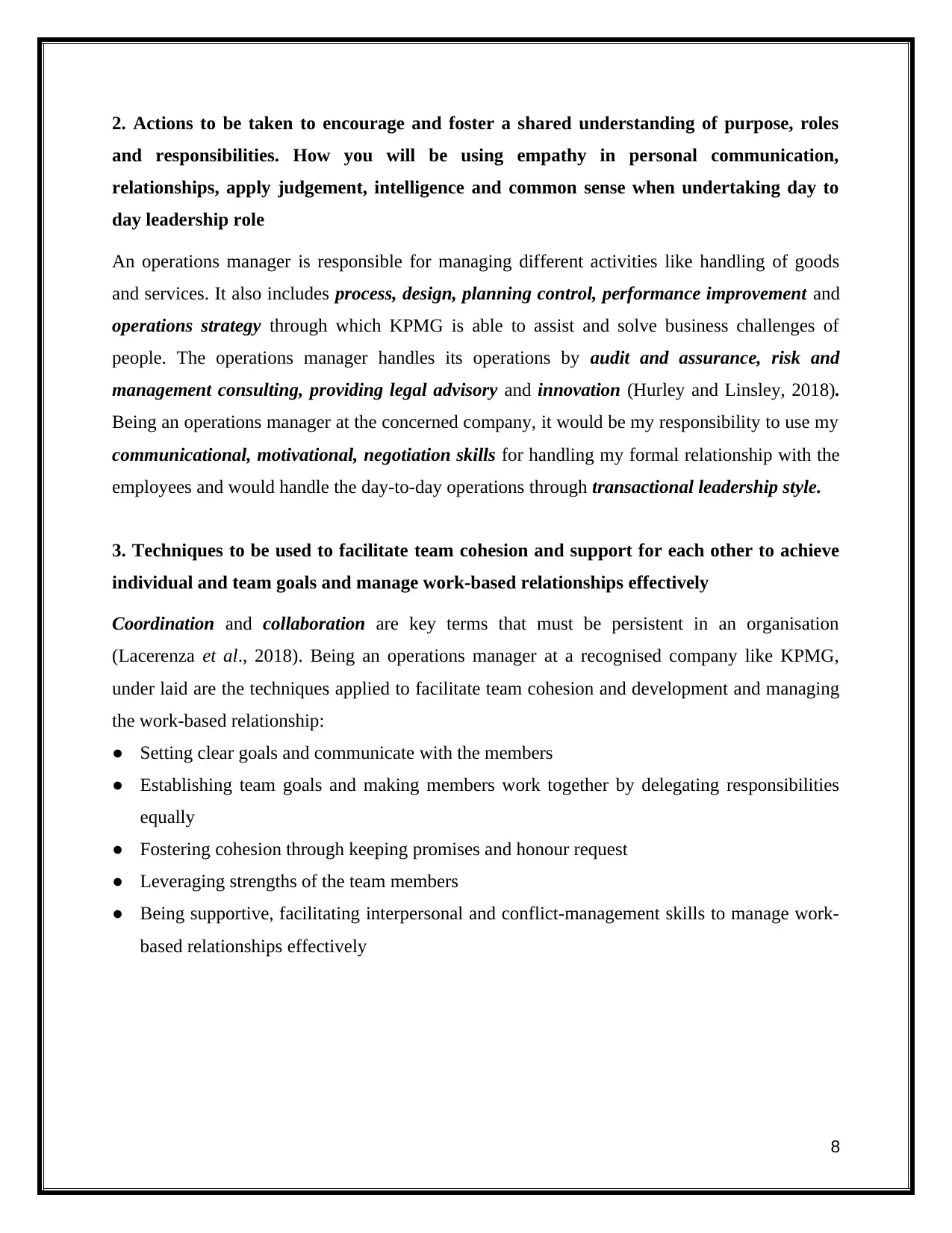
2. Actions to be taken to encourage and foster a shared understanding of purpose, roles
and responsibilities. How you will be using empathy in personal communication,
relationships, apply judgement, intelligence and common sense when undertaking day to
day leadership role
An operations manager is responsible for managing different activities like handling of goods
and services. It also includes process, design, planning control, performance improvement and
operations strategy through which KPMG is able to assist and solve business challenges of
people. The operations manager handles its operations by audit and assurance, risk and
management consulting, providing legal advisory and innovation (Hurley and Linsley, 2018).
Being an operations manager at the concerned company, it would be my responsibility to use my
communicational, motivational, negotiation skills for handling my formal relationship with the
employees and would handle the day-to-day operations through transactional leadership style.
3. Techniques to be used to facilitate team cohesion and support for each other to achieve
individual and team goals and manage work-based relationships effectively
Coordination and collaboration are key terms that must be persistent in an organisation
(Lacerenza et al., 2018). Being an operations manager at a recognised company like KPMG,
under laid are the techniques applied to facilitate team cohesion and development and managing
the work-based relationship:
● Setting clear goals and communicate with the members
● Establishing team goals and making members work together by delegating responsibilities
equally
● Fostering cohesion through keeping promises and honour request
● Leveraging strengths of the team members
● Being supportive, facilitating interpersonal and conflict-management skills to manage work-
based relationships effectively
8
and responsibilities. How you will be using empathy in personal communication,
relationships, apply judgement, intelligence and common sense when undertaking day to
day leadership role
An operations manager is responsible for managing different activities like handling of goods
and services. It also includes process, design, planning control, performance improvement and
operations strategy through which KPMG is able to assist and solve business challenges of
people. The operations manager handles its operations by audit and assurance, risk and
management consulting, providing legal advisory and innovation (Hurley and Linsley, 2018).
Being an operations manager at the concerned company, it would be my responsibility to use my
communicational, motivational, negotiation skills for handling my formal relationship with the
employees and would handle the day-to-day operations through transactional leadership style.
3. Techniques to be used to facilitate team cohesion and support for each other to achieve
individual and team goals and manage work-based relationships effectively
Coordination and collaboration are key terms that must be persistent in an organisation
(Lacerenza et al., 2018). Being an operations manager at a recognised company like KPMG,
under laid are the techniques applied to facilitate team cohesion and development and managing
the work-based relationship:
● Setting clear goals and communicate with the members
● Establishing team goals and making members work together by delegating responsibilities
equally
● Fostering cohesion through keeping promises and honour request
● Leveraging strengths of the team members
● Being supportive, facilitating interpersonal and conflict-management skills to manage work-
based relationships effectively
8
⊘ This is a preview!⊘
Do you want full access?
Subscribe today to unlock all pages.

Trusted by 1+ million students worldwide
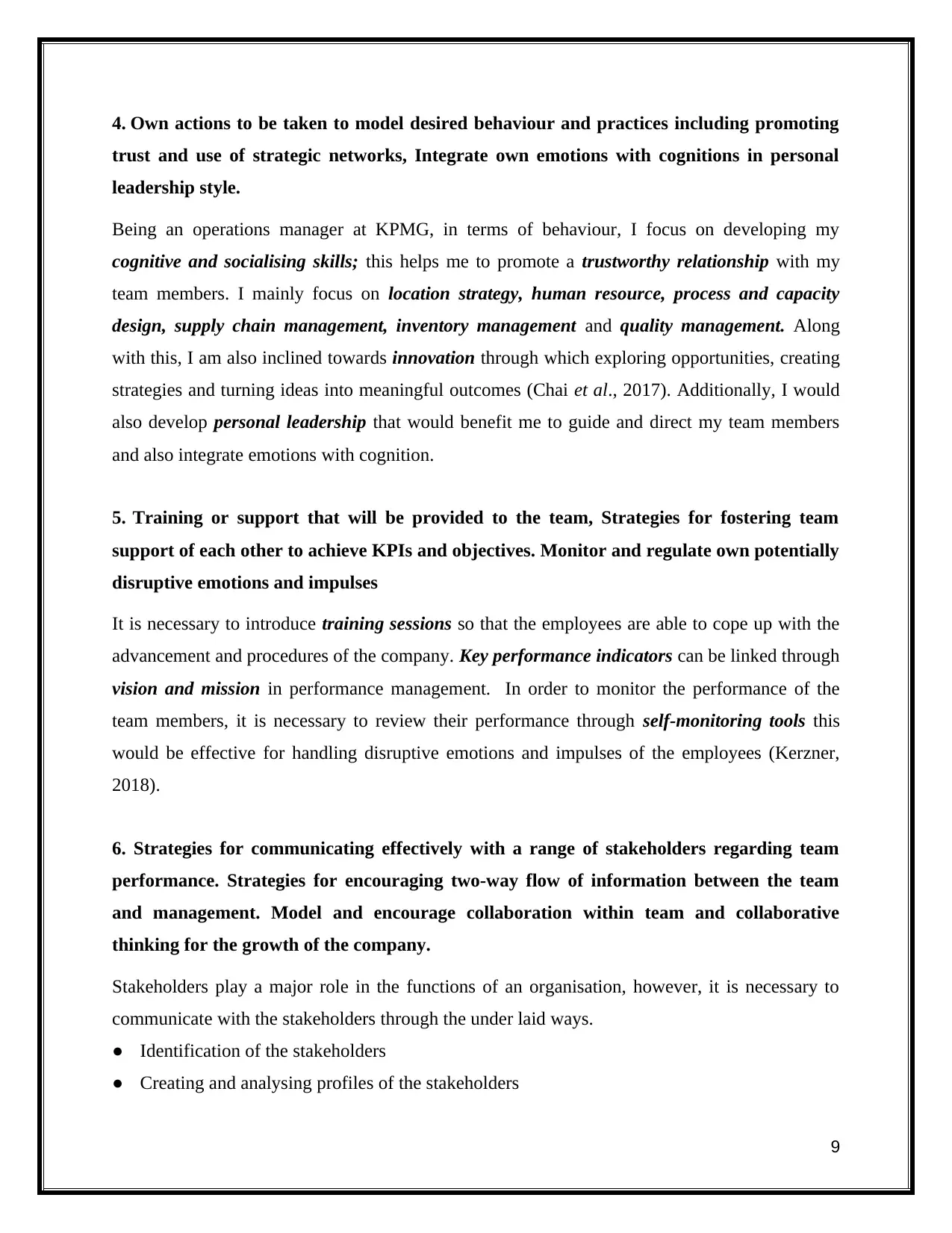
4. Own actions to be taken to model desired behaviour and practices including promoting
trust and use of strategic networks, Integrate own emotions with cognitions in personal
leadership style.
Being an operations manager at KPMG, in terms of behaviour, I focus on developing my
cognitive and socialising skills; this helps me to promote a trustworthy relationship with my
team members. I mainly focus on location strategy, human resource, process and capacity
design, supply chain management, inventory management and quality management. Along
with this, I am also inclined towards innovation through which exploring opportunities, creating
strategies and turning ideas into meaningful outcomes (Chai et al., 2017). Additionally, I would
also develop personal leadership that would benefit me to guide and direct my team members
and also integrate emotions with cognition.
5. Training or support that will be provided to the team, Strategies for fostering team
support of each other to achieve KPIs and objectives. Monitor and regulate own potentially
disruptive emotions and impulses
It is necessary to introduce training sessions so that the employees are able to cope up with the
advancement and procedures of the company. Key performance indicators can be linked through
vision and mission in performance management. In order to monitor the performance of the
team members, it is necessary to review their performance through self-monitoring tools this
would be effective for handling disruptive emotions and impulses of the employees (Kerzner,
2018).
6. Strategies for communicating effectively with a range of stakeholders regarding team
performance. Strategies for encouraging two-way flow of information between the team
and management. Model and encourage collaboration within team and collaborative
thinking for the growth of the company.
Stakeholders play a major role in the functions of an organisation, however, it is necessary to
communicate with the stakeholders through the under laid ways.
● Identification of the stakeholders
● Creating and analysing profiles of the stakeholders
9
trust and use of strategic networks, Integrate own emotions with cognitions in personal
leadership style.
Being an operations manager at KPMG, in terms of behaviour, I focus on developing my
cognitive and socialising skills; this helps me to promote a trustworthy relationship with my
team members. I mainly focus on location strategy, human resource, process and capacity
design, supply chain management, inventory management and quality management. Along
with this, I am also inclined towards innovation through which exploring opportunities, creating
strategies and turning ideas into meaningful outcomes (Chai et al., 2017). Additionally, I would
also develop personal leadership that would benefit me to guide and direct my team members
and also integrate emotions with cognition.
5. Training or support that will be provided to the team, Strategies for fostering team
support of each other to achieve KPIs and objectives. Monitor and regulate own potentially
disruptive emotions and impulses
It is necessary to introduce training sessions so that the employees are able to cope up with the
advancement and procedures of the company. Key performance indicators can be linked through
vision and mission in performance management. In order to monitor the performance of the
team members, it is necessary to review their performance through self-monitoring tools this
would be effective for handling disruptive emotions and impulses of the employees (Kerzner,
2018).
6. Strategies for communicating effectively with a range of stakeholders regarding team
performance. Strategies for encouraging two-way flow of information between the team
and management. Model and encourage collaboration within team and collaborative
thinking for the growth of the company.
Stakeholders play a major role in the functions of an organisation, however, it is necessary to
communicate with the stakeholders through the under laid ways.
● Identification of the stakeholders
● Creating and analysing profiles of the stakeholders
9
Paraphrase This Document
Need a fresh take? Get an instant paraphrase of this document with our AI Paraphraser
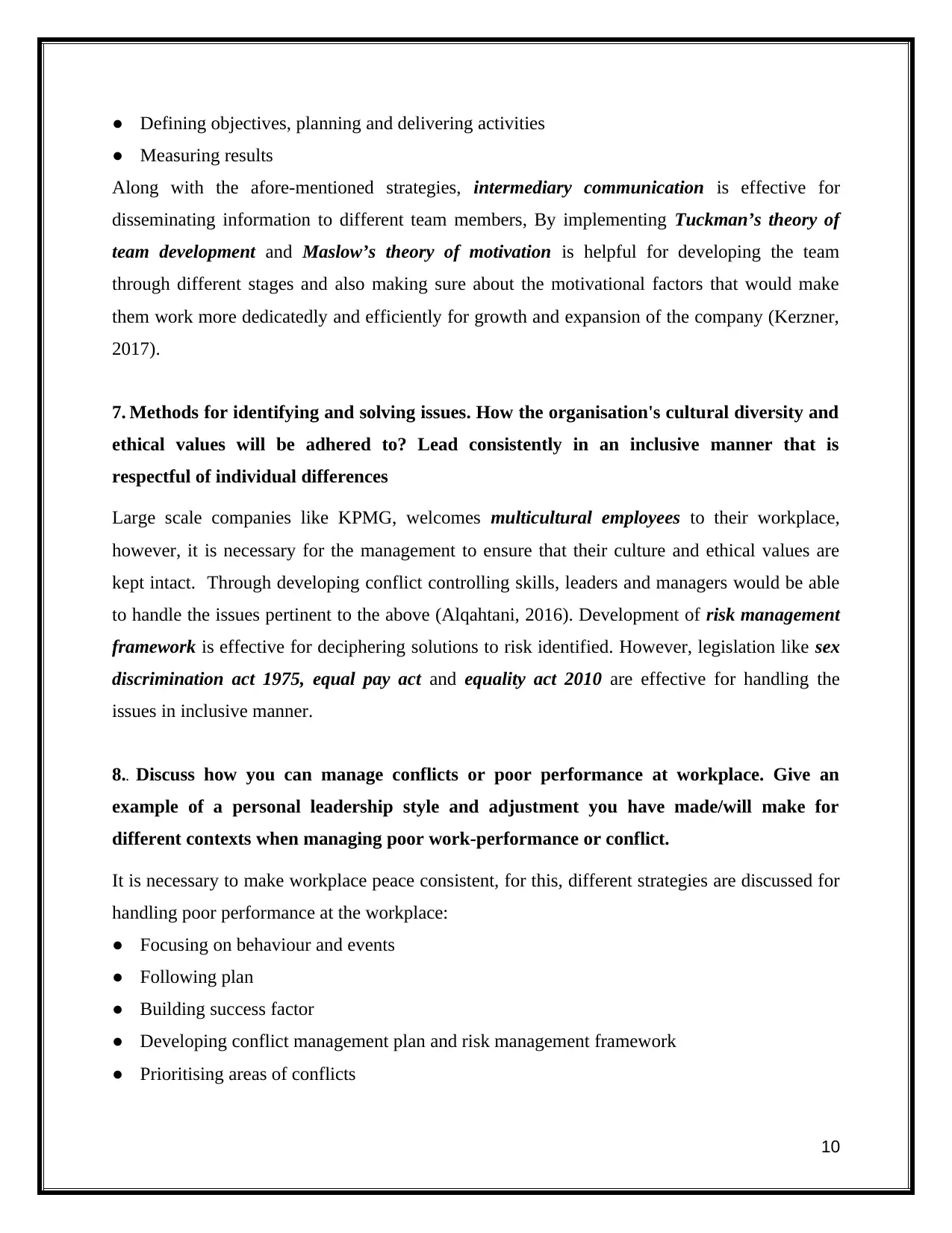
● Defining objectives, planning and delivering activities
● Measuring results
Along with the afore-mentioned strategies, intermediary communication is effective for
disseminating information to different team members, By implementing Tuckman’s theory of
team development and Maslow’s theory of motivation is helpful for developing the team
through different stages and also making sure about the motivational factors that would make
them work more dedicatedly and efficiently for growth and expansion of the company (Kerzner,
2017).
7. Methods for identifying and solving issues. How the organisation's cultural diversity and
ethical values will be adhered to? Lead consistently in an inclusive manner that is
respectful of individual differences
Large scale companies like KPMG, welcomes multicultural employees to their workplace,
however, it is necessary for the management to ensure that their culture and ethical values are
kept intact. Through developing conflict controlling skills, leaders and managers would be able
to handle the issues pertinent to the above (Alqahtani, 2016). Development of risk management
framework is effective for deciphering solutions to risk identified. However, legislation like sex
discrimination act 1975, equal pay act and equality act 2010 are effective for handling the
issues in inclusive manner.
8.. Discuss how you can manage conflicts or poor performance at workplace. Give an
example of a personal leadership style and adjustment you have made/will make for
different contexts when managing poor work-performance or conflict.
It is necessary to make workplace peace consistent, for this, different strategies are discussed for
handling poor performance at the workplace:
● Focusing on behaviour and events
● Following plan
● Building success factor
● Developing conflict management plan and risk management framework
● Prioritising areas of conflicts
10
● Measuring results
Along with the afore-mentioned strategies, intermediary communication is effective for
disseminating information to different team members, By implementing Tuckman’s theory of
team development and Maslow’s theory of motivation is helpful for developing the team
through different stages and also making sure about the motivational factors that would make
them work more dedicatedly and efficiently for growth and expansion of the company (Kerzner,
2017).
7. Methods for identifying and solving issues. How the organisation's cultural diversity and
ethical values will be adhered to? Lead consistently in an inclusive manner that is
respectful of individual differences
Large scale companies like KPMG, welcomes multicultural employees to their workplace,
however, it is necessary for the management to ensure that their culture and ethical values are
kept intact. Through developing conflict controlling skills, leaders and managers would be able
to handle the issues pertinent to the above (Alqahtani, 2016). Development of risk management
framework is effective for deciphering solutions to risk identified. However, legislation like sex
discrimination act 1975, equal pay act and equality act 2010 are effective for handling the
issues in inclusive manner.
8.. Discuss how you can manage conflicts or poor performance at workplace. Give an
example of a personal leadership style and adjustment you have made/will make for
different contexts when managing poor work-performance or conflict.
It is necessary to make workplace peace consistent, for this, different strategies are discussed for
handling poor performance at the workplace:
● Focusing on behaviour and events
● Following plan
● Building success factor
● Developing conflict management plan and risk management framework
● Prioritising areas of conflicts
10
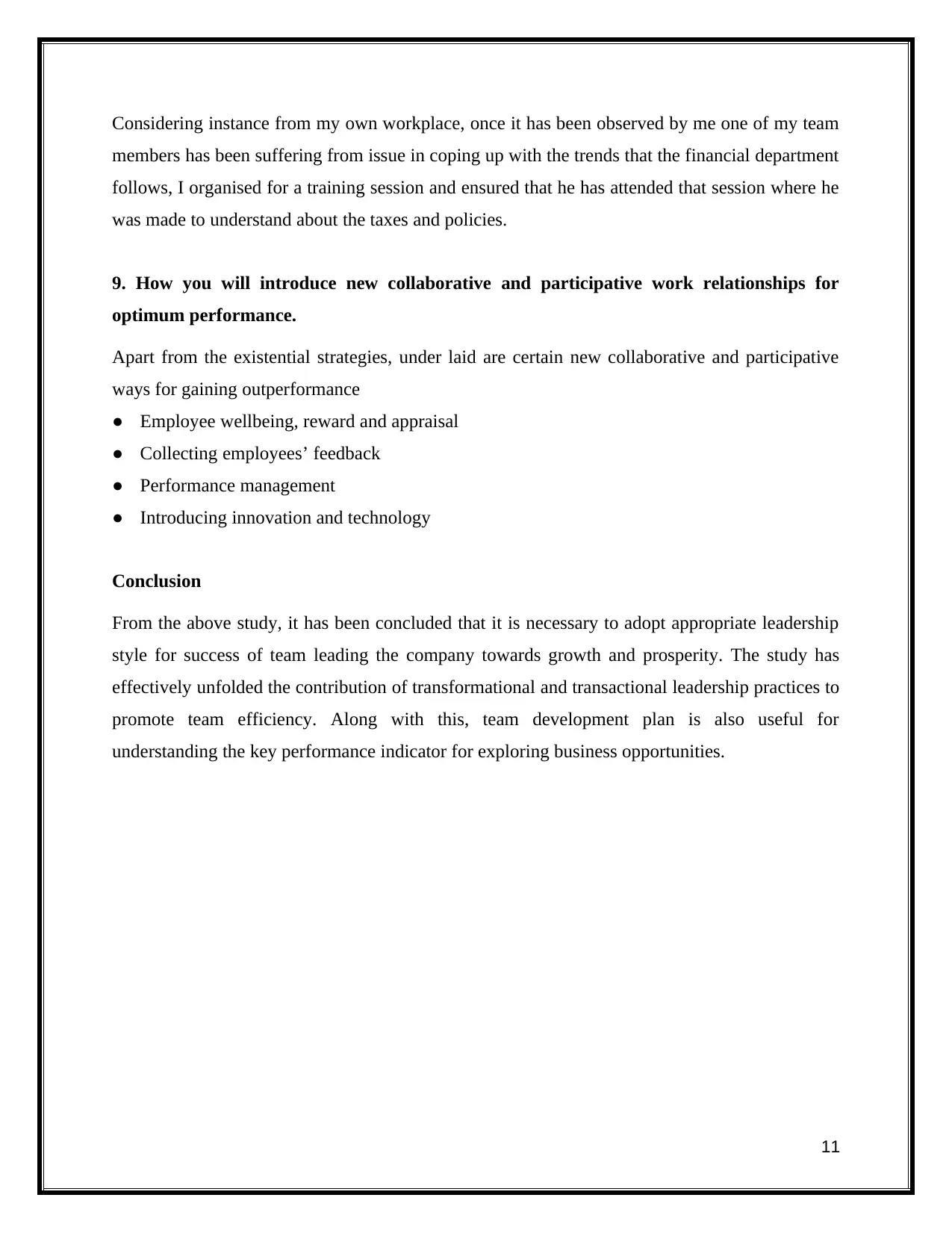
Considering instance from my own workplace, once it has been observed by me one of my team
members has been suffering from issue in coping up with the trends that the financial department
follows, I organised for a training session and ensured that he has attended that session where he
was made to understand about the taxes and policies.
9. How you will introduce new collaborative and participative work relationships for
optimum performance.
Apart from the existential strategies, under laid are certain new collaborative and participative
ways for gaining outperformance
● Employee wellbeing, reward and appraisal
● Collecting employees’ feedback
● Performance management
● Introducing innovation and technology
Conclusion
From the above study, it has been concluded that it is necessary to adopt appropriate leadership
style for success of team leading the company towards growth and prosperity. The study has
effectively unfolded the contribution of transformational and transactional leadership practices to
promote team efficiency. Along with this, team development plan is also useful for
understanding the key performance indicator for exploring business opportunities.
11
members has been suffering from issue in coping up with the trends that the financial department
follows, I organised for a training session and ensured that he has attended that session where he
was made to understand about the taxes and policies.
9. How you will introduce new collaborative and participative work relationships for
optimum performance.
Apart from the existential strategies, under laid are certain new collaborative and participative
ways for gaining outperformance
● Employee wellbeing, reward and appraisal
● Collecting employees’ feedback
● Performance management
● Introducing innovation and technology
Conclusion
From the above study, it has been concluded that it is necessary to adopt appropriate leadership
style for success of team leading the company towards growth and prosperity. The study has
effectively unfolded the contribution of transformational and transactional leadership practices to
promote team efficiency. Along with this, team development plan is also useful for
understanding the key performance indicator for exploring business opportunities.
11
⊘ This is a preview!⊘
Do you want full access?
Subscribe today to unlock all pages.

Trusted by 1+ million students worldwide
1 out of 14
Related Documents
Your All-in-One AI-Powered Toolkit for Academic Success.
+13062052269
info@desklib.com
Available 24*7 on WhatsApp / Email
![[object Object]](/_next/static/media/star-bottom.7253800d.svg)
Unlock your academic potential
Copyright © 2020–2025 A2Z Services. All Rights Reserved. Developed and managed by ZUCOL.





